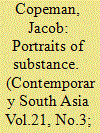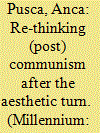| Srl | Item |
| 1 |
ID:
124956


|
|
|
|
|
| Publication |
2013.
|
| Summary/Abstract |
This essay examines the way extractions of human blood - for medical donations, portrait paintings, and petitions - have come to form a significant means of political communication (particularly as a means of political protest) throughout India, focusing in particular on a case study from the south of a karate teacher and artist who, through painting multiple portraits of the Tamil Nadu Chief Minister with his blood, sought land for his karate school. The second half of the essay explores wider features of India's 'sanguinary politics', focusing in particular on ways in which publicly witnessed deployments of political activists' own blood once seemed to promise both intensification and purification of mass political idioms. It also considers how and why this promise has largely remained unfulfilled.
|
|
|
|
|
|
|
|
|
|
|
|
|
|
|
|
| 2 |
ID:
152111


|
|
|
|
|
| Summary/Abstract |
The relationship between art and politics was in many ways uniquely important in communist spaces, where the totalising experience of the communist state and ideology needed to be built quickly and emerge in a way that would completely control the visibility of ‘change’. Not unlike the post-communist transition experience, the communist experience was also dominated by an ethos of aggressive social change and progress. Measuring both change and progress was instrumental to the communist state, and art – especially propaganda art – played an essential role in instigating, legitimising and rendering change visible. From posters, to public statues, to rising industrial platforms and communist blocs, to new avenues and massive public infrastructure projects, the ‘artist’ – whether an architect, painter, plastic artist, performer or poet – was an essential ‘tool’ in the ideological arsenal of the communist state. It is thus not surprising that any serious study of politics in the post-communist context needs to take the question of ‘art’ and ‘aesthetics’ seriously.
|
|
|
|
|
|
|
|
|
|
|
|
|
|
|
|